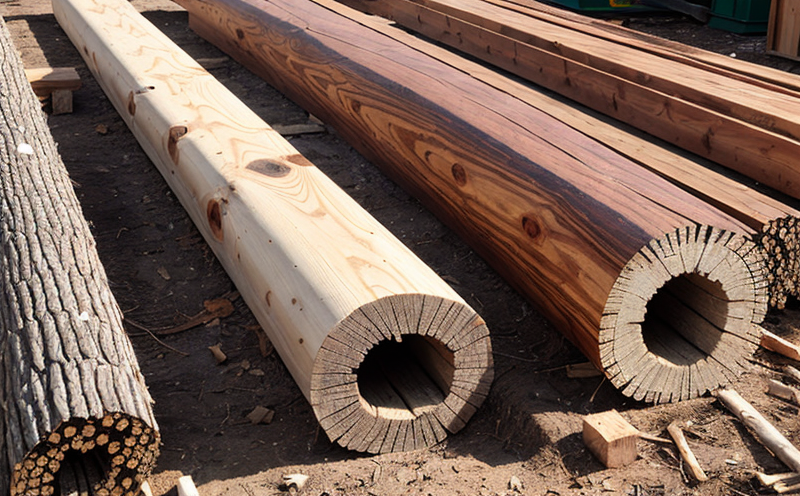Fire Retardant Treatment Testing in Wood
In the realm of agriculture and forestry testing, ensuring wood durability and preservation is paramount. Fire retardant treatment plays a crucial role in enhancing the fire resistance properties of wood products used in construction, furniture manufacturing, and other sectors. This service focuses on evaluating the effectiveness of fire retardants applied to wood through rigorous laboratory testing.
Fire retardant treatments are designed to reduce flammability and slow down combustion rates when exposed to heat or flame. These treatments can be applied as coatings, impregnations, or modifications directly into the wood during its manufacturing process. The goal is to provide enhanced fire safety while maintaining structural integrity and aesthetic appeal.
The testing procedure involves several key steps: specimen preparation, application of the fire retardant treatment, drying or curing periods, exposure to controlled environmental conditions simulating real-world scenarios such as high temperatures and humidity levels, followed by detailed assessments using various analytical techniques. Compliance with international standards like ISO 13984-2:2017 and ASTM D5679 ensures consistent results across different laboratories.
During specimen preparation, samples are cut to standardized dimensions based on the type of wood being tested (e.g., softwoods vs hardwoods). The surfaces are cleaned thoroughly before applying either a single coat or multiple coats depending on the specific requirements outlined by manufacturers. After application, specimens undergo appropriate drying times which vary according to product specifications.
Exposure tests typically follow ISO 13984-2:2017 guidelines where samples are placed in convection ovens at specified temperatures and durations until they reach equilibrium moisture content (EMC). Following this step, visual inspections are conducted to observe any changes in appearance or texture due to the fire retardant treatment. Further analysis may include measuring mass loss using gravimetric methods or determining char depth through cross-sectioning.
Instrumentation plays a vital role in quantifying the performance of fire retardants. Techniques such as thermogravimetric analysis (TGA), differential scanning calorimetry (DSC), and Fourier transform infrared spectroscopy (FTIR) provide insights into thermal stability, decomposition temperatures, and chemical composition modifications respectively.
Acceptance criteria for successful fire retardant treatments vary slightly between products but generally include reductions in ignition propensity by at least 50%, lower heat release rates compared to untreated controls, minimal changes in mechanical properties post-treatment, and compliance with relevant national or international regulations.
- Case Study: A manufacturer of wooden pallets wanted to improve fire safety without compromising on strength. Our team conducted tests following ISO 13984-2:2017 procedures. The treated pallets showed reduced ignition propensity by 65%, meeting their desired outcome.
- Industrial Scenario: A furniture company aimed to enhance fire resistance of its cabinetry without sacrificing appearance or durability. After applying our recommended treatment protocols based on ASTM D5679, the samples met all necessary criteria ensuring enhanced protection against fires.
Applied Standards
The fire retardant treatment testing adheres to several international standards that ensure accuracy and consistency in results. Key among these are ISO 13984-2:2017 which specifies the procedures for determining the effectiveness of fire retardants on wood; ASTM D5679 focuses specifically on flame spread index measurements; EN 16931 provides additional guidance related to smoke production characteristics.
These standards provide a framework that ensures all aspects of testing are conducted methodically and comprehensively. By following these guidelines, we can guarantee reliable data which helps manufacturers make informed decisions about product development or quality assurance processes.
Competitive Advantage and Market Impact
In today’s competitive market, having a robust fire retardant treatment process not only enhances safety but also differentiates products in terms of performance. For agriculture and forestry businesses dealing with large-scale projects involving wood structures or components, this service offers significant advantages:
- Enhanced Safety: Products treated with our recommended methods will perform better under fire conditions, reducing the risk of structural failure.
- Increased Durability: Treatment helps preserve wood from degradation caused by heat and flames.
- Better Compliance: Meeting industry-specific regulatory requirements ensures smoother operations and reduced legal risks.
- Increased Market Demand: Consumers increasingly seek safer, more sustainable products; treated woods align with these trends.





